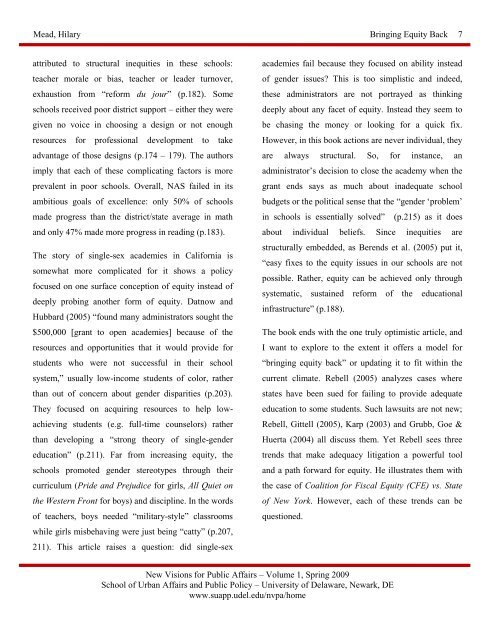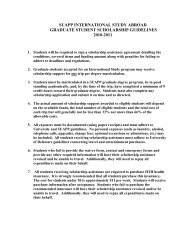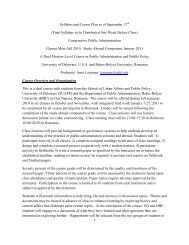New Visions for Public Affairs Volume 1 - School of Public Policy ...
New Visions for Public Affairs Volume 1 - School of Public Policy ...
New Visions for Public Affairs Volume 1 - School of Public Policy ...
You also want an ePaper? Increase the reach of your titles
YUMPU automatically turns print PDFs into web optimized ePapers that Google loves.
Mead, Hilary Bringing Equity Back 7<br />
attributed to structural inequities in these schools:<br />
teacher morale or bias, teacher or leader turnover,<br />
exhaustion from “re<strong>for</strong>m du jour” (p.182). Some<br />
schools received poor district support – either they were<br />
given no voice in choosing a design or not enough<br />
resources <strong>for</strong> pr<strong>of</strong>essional development to take<br />
advantage <strong>of</strong> those designs (p.174 – 179). The authors<br />
imply that each <strong>of</strong> these complicating factors is more<br />
prevalent in poor schools. Overall, NAS failed in its<br />
ambitious goals <strong>of</strong> excellence: only 50% <strong>of</strong> schools<br />
made progress than the district/state average in math<br />
and only 47% made more progress in reading (p.183).<br />
The story <strong>of</strong> single-sex academies in Cali<strong>for</strong>nia is<br />
somewhat more complicated <strong>for</strong> it shows a policy<br />
focused on one surface conception <strong>of</strong> equity instead <strong>of</strong><br />
deeply probing another <strong>for</strong>m <strong>of</strong> equity. Datnow and<br />
Hubbard (2005) “found many administrators sought the<br />
$500,000 [grant to open academies] because <strong>of</strong> the<br />
resources and opportunities that it would provide <strong>for</strong><br />
students who were not successful in their school<br />
system,” usually low-income students <strong>of</strong> color, rather<br />
than out <strong>of</strong> concern about gender disparities (p.203).<br />
They focused on acquiring resources to help lowachieving<br />
students (e.g. full-time counselors) rather<br />
than developing a “strong theory <strong>of</strong> single-gender<br />
education” (p.211). Far from increasing equity, the<br />
schools promoted gender stereotypes through their<br />
curriculum (Pride and Prejudice <strong>for</strong> girls, All Quiet on<br />
the Western Front <strong>for</strong> boys) and discipline. In the words<br />
<strong>of</strong> teachers, boys needed “military-style” classrooms<br />
while girls misbehaving were just being “catty” (p.207,<br />
211). This article raises a question: did single-sex<br />
academies fail because they focused on ability instead<br />
<strong>of</strong> gender issues? This is too simplistic and indeed,<br />
these administrators are not portrayed as thinking<br />
deeply about any facet <strong>of</strong> equity. Instead they seem to<br />
be chasing the money or looking <strong>for</strong> a quick fix.<br />
However, in this book actions are never individual, they<br />
are always structural. So, <strong>for</strong> instance, an<br />
administrator‟s decision to close the academy when the<br />
grant ends says as much about inadequate school<br />
budgets or the political sense that the “gender „problem‟<br />
in schools is essentially solved” (p.215) as it does<br />
about individual beliefs. Since inequities are<br />
structurally embedded, as Berends et al. (2005) put it,<br />
“easy fixes to the equity issues in our schools are not<br />
possible. Rather, equity can be achieved only through<br />
systematic, sustained re<strong>for</strong>m <strong>of</strong> the educational<br />
infrastructure” (p.188).<br />
The book ends with the one truly optimistic article, and<br />
I want to explore to the extent it <strong>of</strong>fers a model <strong>for</strong><br />
“bringing equity back” or updating it to fit within the<br />
current climate. Rebell (2005) analyzes cases where<br />
states have been sued <strong>for</strong> failing to provide adequate<br />
education to some students. Such lawsuits are not new;<br />
Rebell, Gittell (2005), Karp (2003) and Grubb, Goe &<br />
Huerta (2004) all discuss them. Yet Rebell sees three<br />
trends that make adequacy litigation a powerful tool<br />
and a path <strong>for</strong>ward <strong>for</strong> equity. He illustrates them with<br />
the case <strong>of</strong> Coalition <strong>for</strong> Fiscal Equity (CFE) vs. State<br />
<strong>of</strong> <strong>New</strong> York. However, each <strong>of</strong> these trends can be<br />
questioned.<br />
<strong>New</strong> <strong>Visions</strong> <strong>for</strong> <strong>Public</strong> <strong>Affairs</strong> – <strong>Volume</strong> 1, Spring 2009<br />
<strong>School</strong> <strong>of</strong> Urban <strong>Affairs</strong> and <strong>Public</strong> <strong>Policy</strong> – University <strong>of</strong> Delaware, <strong>New</strong>ark, DE<br />
www.suapp.udel.edu/nvpa/home







